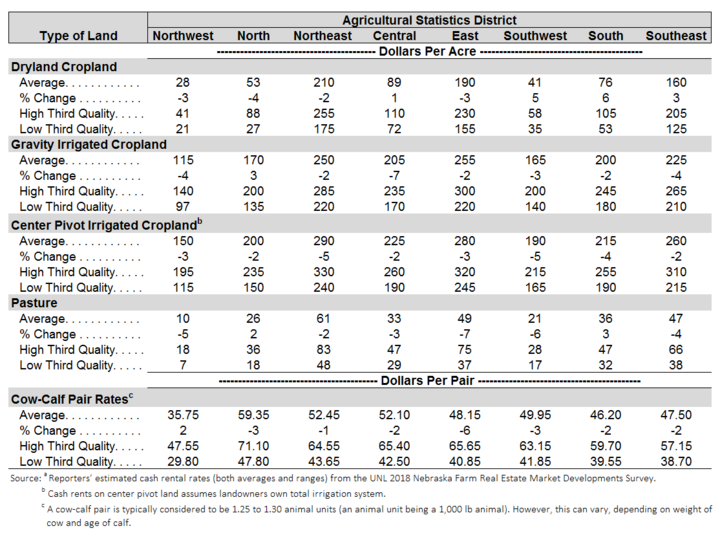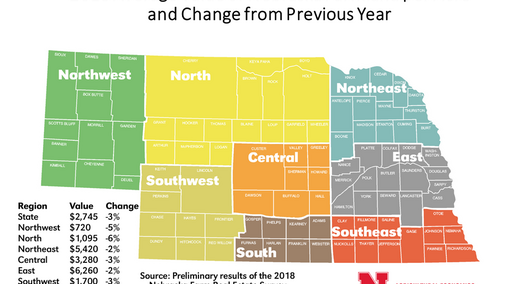Average Nebraska ag land value dropped 3% from last year, according to a preliminary report of the 2018 Nebraska Farm Real Estate Market survey. That's less than the 9% drop reported in 2017 and similar to the 4% drop reported in spring 2016.
The average market value of Nebraska farmland declined by 3% over the prior year to $2,745 per acre, according to a preliminary report of the 2018 Nebraska Farm Real Estate Market Survey (Table 1). This marks the fourth consecutive year of downward pressure. Market values have dropped 17% since reaching a high of $3,315 in 2014.
The University of Nebraska-Lincoln Department of Agricultural Economics annually surveys Nebraska land professionals including appraisers, farm and ranch managers, and agricultural bankers. Results from the survey are divided by land class and summarized by the eight Agricultural Statistic Districts of Nebraska.
Survey participants pointed to low commodity prices over the prior year and current property tax policies as the reason for declining farm real estate values.
| Region | Value | Change |
|---|---|---|
| State | $2,745 | -3% |
| Northwest | $720 | -5% |
| North | $1,095 | -6% |
| Northeast | $5,420 | -2% |
| Central | $3,280 | -3% |
| East | $6,260 | -2% |
| Southwest | $1,700 | -3% |
| South | $3,775 | -3% |
| Southeast | $4,810 | -1% |
Tillable grazing land values declined by 6%, the largest percentage decline of the seven land classes. Sharp drops in the northeast (11%) and central (10%) districts contributed to the overall reduction in tillable grazing land values. Hayland in the central and southwest districts also experienced 10% declines in value.
Survey participants pointed to low commodity prices over the prior year and current property tax policies as the reason for declining Nebraska farm real estate values.
Values for dryland and irrigated cropland across Nebraska declined 1%-7%. In several districts land values increased 2%-6%, but these instances were small, indicating a fairly unchanged land market for the region.
Future prospects for cropland in Nebraska remain interlaced with the earning potential for the major commodities grown across the state, input expenses, and monetary policies influencing the cost of borrowing for future land purchases. Regulation policies guiding the use of water for irrigation were also noted as a potential driver for the changes in the future value of irrigated cropland in certain areas of the state, according to survey participants.
Land classes serving the cow-calf industry, including grazing land and hayland, experienced a wide range in declines between 1% and 10% across the state. In several districts, tillable grazing land and hayland reported small gains of 2%-6%.
According to survey participants, demand for beef and availability of forages during periods of drought were two of the major drivers for the future value of land classes serving the cow-calf industry. Recent increases in exports of beef from Nebraska to China remain critical for the value of cattle raised in the state. Also, extended periods of drought may increase the price and availability of forages influencing the potential market value of hayland.
Ag Land Rental Rates
On average, rental rates for dryland and irrigated cropland along with grazing land for pasture or cow-calf pairs trended down about 2%-7% (Table 3). Irrigated cropland rental rates on average declined 2%-5% across Nebraska with a small increase noted in the north district. For dryland cropland, the central, southwest, south, and southeast districts experienced small increases.
Survey participants indicated that property taxes are one of the landowners' most critical concerns during rental negotiations. Landlords face the prospects of low returns on their land after accounting for property taxes. Tenants face tight cash flows with current commodity prices, input expenses, and rental payments. Negotiating an equitable rental rate remains a challenge for landlords and tenants.
Division of annual maintenance and upkeep expenses for irrigation equipment is also a major consideration during rental negotiations. Tenants willing to provide maintenance services on irrigation equipment need to bring these expenses up in negotiations to equitably account for their contribution to the leases.
Pasture and cow-calf pair rental rates were mixed, depending on the district. Most districts experienced declines of 2%-7%, but some saw increases of 2%-3%.
Several other considerations besides the productivity of the grazing land factor into the rental rates, according to survey participants. These include annual fence maintenance, weed control, removal of unwanted brush or cedar trees, and watering systems for livestock when applicable.
Survey Background
Land values and rental rates presented in this report are averages of survey participants’ responses by district. Actual land values and rental rates may vary depending upon the quality of the parcel and local market for an area. Also, preliminary land values and rental rates are subject to change as additional surveys are returned.
Final results from the survey will be published in June 2018 and will be available online at Nebraska Farm Real Estate.
More Information
Please address questions regarding preliminary estimates from the 2018 Nebraska Farm Real Estate Survey to the author, Jim Jansen at 402-261-7572 or jjansen4@unl.edu.
Table 2. Preliminary average reported value of Nebraska ag land for different land types and regions of the state, February 1, 2018a

Table 3. Preliminary reported cash rental rates for various types of Nebraska farmland and pasture: 2018 averages, percent change from 2017 and quality ranges by Agricultural Statistics Districta


